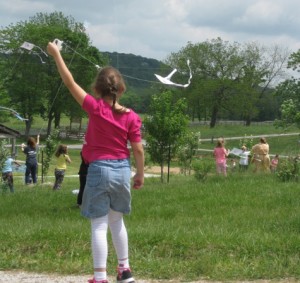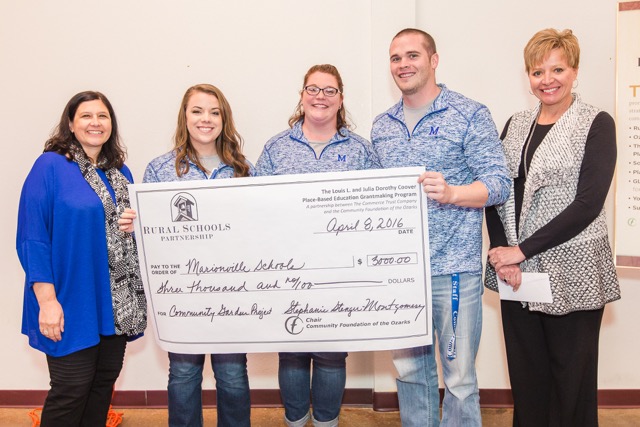
Supporting Rural Schools
Supporting Rural Schools
A community foundation's Rural Schools Partnership brings arts education and other supports to rural schools in Missouri.
There are a lot of good days when you work for a community foundation, particularly one as diverse and action-oriented as the Community Foundation of the Ozarks (CFO). Even so, a spring morning spent at the Baker Creek Pioneer Village, watching first graders fly homemade kites amid a blooming spring peach orchard has to rank near the top of that list.
The first graders were from Willow Springs, Mo., a town of just more than 2,000 in Howell County, a rural county in southern Missouri that includes a picturesque chunk of the Mark Twain National Forest. The occasion was one of those traditional spring field trips you remember from childhood, this one to Baker Creek, a throwback heirloom seed farm and village located about an hour west of Willow Springs, near Mansfield (perhaps best known as the town where Laura Ingalls Wilder eventually settled and where there is now a museum dedicated to her work). Kids sat on hay bales and ate sack lunches. They watched planting demonstrations and learned about native Missouri flora and fauna. It was a full day for any student – not to mention their teachers.

The kites were the culmination of a multi-week effort of the Placeworks Art Initiative, just one of the programs funded by the CFO’s Rural Schools Partnership (RSP), an effort established in 2009 to strengthen rural districts and the communities they serve. Predominantly rural, a significant portion of the Missouri Ozarks is designated by the United States Department of Agriculture as an area of “persistent poverty.” Many of the poorest counties in the state – and in the country – are in this region and are the focus of CFO’s work.
Placeworks, for example, is an interdisciplinary program that uses artistic projects and interpretation to enrich classroom learning and help students meet instructional goals. And as budget and curriculum constraints have made it increasingly difficult for schools to offer comprehensive arts programs of their own, initiatives like Placeworks have grown in significance as a way to expose children to arts and learning opportunities. In the case of the kites, a classroom unit on the life cycle of the butterfly morphed into a lesson on visual and structural symmetry (in the form of butterfly wings drawn and painted on kites) and even Japanese culture. A perfectly breezy Missouri spring day did the rest.
12 of the poorest counties in Missouri are located in the Ozarks.
Other recent Placeworks projects have included writing music and filming live-action music videos, large-scale art installations for campuses and buildings and responding to visual art through dramatic interpretation. All units also include a fully funded field trip to the Springfield Art Museum – an important Placeworks partner – increasing museum access and awareness for students who may not often have the opportunity to travel to Springfield. Under the guidance of coordinator Kate Baird, Placeworks has visited 26 districts since 2010, working with more than 4,300 students in districts that are members of the Rural Schools Partnership. Thanks to generous donors, Placeworks teaching artists design and teach the lessons free of charge for teachers who apply. Districts need only be members of the Rural Schools Partnership.
All told, the RSP and its partner schools oversee more than $30 million in funding for efforts aimed at bolstering rural schools, including programs like Placeworks. The core mission of the RSP is three-pronged: to develop alternative (non-governmental) resources for rural districts; to promote collaborations and partnerships; and to promote place-based education strategies that contextualize student learning by drawing on a community’s unique history, geography and identity.
Another successful RSP effort is the Ozarks Teacher Corps, launched in 2010 and funded by the Chesley and Flora Lee Wallis Scholarship Fund, an endowed fund administered by the CFO. Each spring, ten or so rising college juniors studying at Ozarks’ colleges and universities are selected for this two-year program. In exchange for a $4,000, two-year renewable scholarship, plus extensive training and development opportunities, these students agree to teach at least the first three years of their career in a rural Ozarks district, preferably their hometowns. Since its advent in 2010, the Ozarks Teacher Corps has graduated more than 60 members from regional colleges and universities. More than 90 percent of them have been placed in rural districts, and most still teach there today.
The brainchild of then CFO-president Dr. Gary Funk, the RSP has since become a national model for the impact districts can have on community betterment in rural places, where schools are not only the beating heart of community activity, but also of identity and passion. In the past year, the RSP and the Rural Schools Collaborative – another project of Funk’s – have organized a national network with similar initiatives in Alabama, Arkansas, Illinois, South Dakota, Wisconsin and California, among others. This month, a national conference explored the idea of expanding the Ozarks Teacher Corps as a national model. It’s small-scale philanthropy on a wide scope.
The CFO’s focus on rural needs, and rural schools in particular, is a necessity as much as it is a passion. The CFO covers the entirety of Missouri south of the Missouri River, from Joplin in the west to Ste. Genevieve in the east, from mid-Missouri’s “wine country” in the north to the Arkansas border. It’s a region as diverse as it is expansive, and includes 10 of the 12 poorest counties in Missouri, primarily in the south-central and Bootheel regions. To increase local influence, the CFO has 49 affiliate foundations, led by volunteer boards and supported by foundation staffers in Springfield, West Plains and Cape Girardeau.
For example, the Louis L. and Julia Dorothy Coover Grantmaking Program is a CFO fund co-managed by the Commerce Trust Co. that offers two annual rounds of support to grantees, one for regional nonprofits and one for rural education (which largely funds the Placeworks program). This program is made possible by the generosity of the late Mrs. Coover, a longtime Commerce Bank employee, who established the program in honor of her husband. Since its inception in 1992, the Coover Charitable Grantmaking program has awarded about $4.6 million to communities and schools across central and southern Missouri.
The Coover program is one of the most dramatic examples of charitably minded donors leaving a lasting legacy to a cause they care about. Similar programs for environmental and water-quality needs and hunger issues, as well as hundreds of thousands of dollars in scholarships for rural students have dramatically improved the quality of life for the rural cities and their citizens. In all, the CFO manages about $250 million in charitable assets (as of March 31, 2016).

The Rural Schools Partnership is a $30 million effort aimed at expanding educational opportunities in rural schools.
Fully half of these assets are earmarked for the CFO’s affiliate areas, including the $30 million specifically for rural school partners. Much of this $30 million fund is held by rural school foundations that share the CFO’s founding policy that long-term, permanent assets are the best tool for creating sustainable funding, now and into the future. In a region with a perceived lack of wealth, the ability of towns and citizens to come together and create lasting endowments for the good of their schools has been nothing short of remarkable.
The CFO and its battalion of rural advocates know that the struggle for rural school districts is very real, and not one that is going to go away. The RSP’s place-based approach to impact encourages self-sufficiency on the part of our cities, promotes an abiding respect for history and heritage, and – in the end – upholds a bit of that “show-me” attitude that has long been a source of pride in Missouri, and in the Ozarks in particular. But most importantly, our philanthropy reflects our core belief: Place matters.
Matt Lemmon is the Media Director for the Community Foundation of the Ozarks.
Project
Rural Schools Partnership
Philanthropy
Community Foundation of the Ozarks


